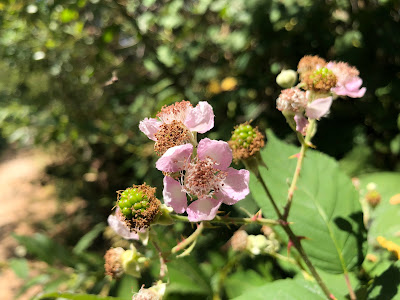 |
Part of the Map of the Gold Regions of California, 1850, by Robert H. Ellis. The Preserve is a non-contiguous patchwork of wetlands in the circled area, near the confluence of the Cosumnes and Mokolumne Rivers, and numerous creeks. [Click pic for details.] Note that the area around was marked out as "Fine Pasturage," "Fine Grazing," and "Elk abundant."
|
Above: the Tules -- marshes with rushes, cat-tails (Typha latifolia) sedges, etc.
 |
Old railway bridge over the Cosumnes
|
 |
| Panorama of the Mokulmne just above the confluence. |

"The Cosumnes River diverges from the popular history of California’s rivers as the last
river without a major dam and as the home of some of the largest native habitats remaining in the
Central Valley. Of the 20 rivers draining the western Sierra Nevada Mountains, only the
Cosumnes River runs free. Large dams impede the flow of the 19 other rivers to generate a
reliable urban water supply and to help irrigate seven million acres of farmland in the Central
Valley. A century and a half ago, that farmland was a landscape of native habitat occupied and
managed by Native Americans. White settlers, who started arriving to California in droves in the
1850s, valued the land for its profit potential and not its native habitat and biodiversity. Today,
the opposite is true. The powerful environmental nonprofit, The Nature Conservancy (TNC), and
a leading waterfowl conservation organization, Ducks Unlimited, established the Cosumnes
River Preserve (CRP) in 1987 to protect the river’s free flow and native flora and fauna (notably
its unique riparian—river bank—forest) and to restore the river’s floodplain."
-- Michelaina Johnson, Evading Dam-Nation:
Land Use History of the Lower Cosumnes River Watershed, ca. 1820-2016
Full text of Evading Dam-Nation
 |
Huge Valley oaks, Quercus lobata, dominate the floodplain woods.
|
 |
| The gall! Oaks here are especially prone to colonization by gall-wasps. |
 |
Above: Oregon ash, Fraxinus latifolia, crowds the stream banks, jangling their keys.
Below: Rubex ursinus, California blackberry, raises impenetrable thickets in the understory, offering delicious fruit at the trailside. |
Wild grapes, Vita californica, also ramble through the thickets.
 |
| Buttonwillow -- Cephalanthus occidentalis v. californicus |
 |
| Umbrella sedge -- Cyperus eragrostis |
 |
Above: Santa Barbara (aka Valley) sedge, Carex barbarae, fills in the cool, shady forest floor.
Below: narrow-leaf milkweed, Asclepias fascicularis, attracts red milkweed beetles, Tetraophes tetrophthalamus. |
 |
| Mat grass is the too-prosaic name for these tiny, exquisite, tricolor meadow flowers, Phyla nodifolia. (The bindweed flower is about two inches across, for scale.) |
 |
| American licorice -- Glycyrrhyza lepidota |
 |
Sneeze-weed, Helenium puberulum, is the ridiculous name of a ridiculous native plant. The striking globes are about a half-inch in diameter. |
 |
| Cocklebur -- Xanthium strumarium. Botanists have assumed this ubiquitous weed was an invasive from Asia, where it is also ubiquitous. But recently, it seems, some are reckoning that this is in fact a North American plant (thus native to California) which has invaded Asia. Either way, it is not too hard to conjecture that this Delta region of California was a key interface area for the exchange of species, since it was the common gateway to the Gold Rush for both Chinese immigrants and Yankee Argonauts. See the map above. |
Cosumnes River Preserve Herbarium -- Comprehensive survey (507 pages of photos!) from UC Davis





















































